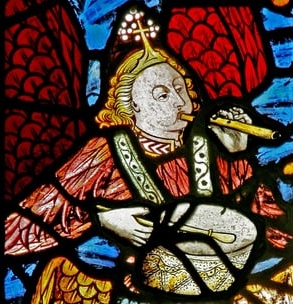pipe and tabor players as
architectural features in the UK
Beauchamp Chapel, St Mary's, Warwick
stained glass window
 source window S1 source window S1 |
 source source |
The early Norman church was rebuilt in the 14th century.
The glass in the Beauchamp Chapel was probably produced in the early 1450s and was the work of the royal glazier John Prudde. This glass was some of the most expensive produced in England during the 15th century. Prudde charged 2 shillings per square foot for the work. The excessive cost was a consequence of a number of factors. The quality of the glass used was high, the patron Richard Beauchamp wanted only the most expensive 'Rhenish' glass imported from the Low Countries for the work. Prudde used this imported glass lavishly, using it for grounds behind figures, instead of the usual white quarries. He also used expensive techniques in the work such as 'jewelling', the leading-in of pieces of coloured glass into hand drilled holes.
Toby says
"I recently heard a seminar paper by Dr Alexandra Buckle of St Hilda's College, Oxford. Alex has got new, high-quality images of surviving C15 stained glass in the chapel and these include an angel playing pipe and tabour and two angels, one on pipe and one on tabor; the musicians are grouped in 'consorts' and it looks as if the taborers, too, were thought of as playing together."
one-hand player
Notes
more images 'Fit for a King': Music and Iconography in Richard Beauchamp's Chantry Chapel' Alexandra Buckle, Early Music (2009)
top of page